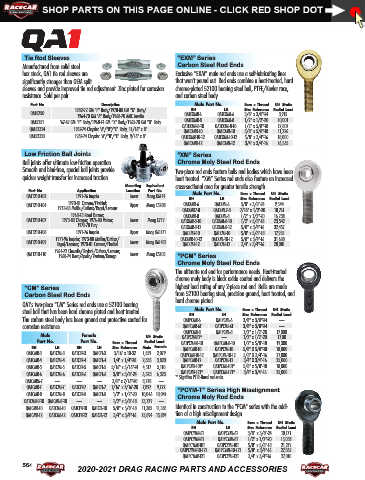Page 569 - 2020-2021 Racecar Engineering Drag Racing Parts and Accessories Catalog
P. 569
2020 DRAG RACING
Redline Gauges NEW! Extreme Gauges
Lightweight and accurate, Redline 2-5/8" dia. stepper motor gauges Gauges were designed with the serious racer in
feature a programmable warning function to quickly alert the driver in the mind. Lightweight, 2-5/8" diameter gauges feature
event of a problem. Sold complete with necessary senders, gauges require white dial faces with bright red pointers and built-in
sensor junction blocks for proper installation. LED back lighting. Gauges may be set up for the
back-lighting to change colors automatically if a
problem arises by simply purchasing the necessary
senders.
Part No. Description
QRP611-7000 Fuel Pressure, 0-15 PSI
QRP611-7003 Oil Pressure, 0-100 PSI
QRP611-7006 Water Temperature, 100°-280°F
QRP69-000 QRP69-003 QRP69-006 QRP611-7007 Voltmeter, 8-18 Volts
Part No. Description QRP611-7009 Oil Temperature, 100°-320°F
QRP69-000 Fuel Pressure, 0-15 PSI Pressure And Temperature Switches
QRP69-003 Oil Pressure, 0-100 PSI QRP61-730 Fuel Pressure Switch, 1/8" NPT, Activates Light At 4 PSI
QRP69-006 Water Temperature, 100°-280°F QRP61-733 Oil Pressure Switch, 1/8" NPT, Activates Light At 30 PSI
QRP69-007 Volt Meter, 8-18 Volts QRP61-735 Oil Pressure Switch, 1/8" NPT, Activates Light At 20 PSI
QRP69-009 Oil Temperature, 140°-320°F QRP61-740 Water Temperature Switch, 1/2" NPT, Activates Light At 235°F
Related Components QRP61-748 Water Temperature Switch, 3/8" NPT, Activates Light At 235°F
QRP63-120 Two-Terminal Sensor Junction QRP61-750 Oil Temperature Switch, 1/2" NPT, Activates Light At 280°F
QRP63-121 Two-Terminal Sensor Junction With (1) Accessory Hole
QRP63-130 Three-Terminal Sensor Junction Performance Gauges
QRP63-132 Three-Terminal Sensor Junction With (2) Accessory Holes
Affordable, illuminated 2-5/8" diameter gauges have
Mini Fuel Pressure Gauges silver dial faces with bright red pointers.
Part No.
Description
Ideally mounted to fuel pressure regulators or fuel QRP611-6000 Fuel Pressure, 0-15 PSI
logs, mini 1-1/2” diameter fuel pressure gauges are QRP611-6003 Oil Pressure, 0-100 PSI
liquid-filled to ease readability. QRP611-6006 Water Temperature, 140°-280°F
QRP611-6009 Oil Temperature, 140°-340°F
Part No. Description
QRP611-9015 0-15 PSI
QRP611-90100 0-100 PSI
TECH
Flick Of The Switch
While a properly wired car is often taken for granted, a poorly wired one can create a myriad of problems. If a racer adds accessories such as a trans-brake,
nitrous functions or a brake shut-off, for example, and if the installation was done in haste, the underside of the dash may have become a rat’s nest of wiring. While it’s not
uncommon for some cars to need a general “clean-up” to repair a poorly wired circuit or two, some cars may require a complete re-wire. The first step should involve installing
the battery cables. Fine stranded cable works best that is a minimum of 4 gauge. Applications that are subject to heavy electrical loads, such as those using 16-volt batteries,
should instead employ 2 or 0 gauge cable. After the cable has been cut to the desired length, ring terminals may be crimped and soldered on each end, and then sealed with
heat shrink. If a master disconnect switch is required, it should be installed and wired in as well. Disconnect switches provide track safety personnel direct access to shutting
down the car’s electrical system in the event of a mishap.
Following the cutting and termination of the ground cable, it should run directly from the battery to the engine block. It is very important that the contact surfaces
of grounds are clean and free of corrosion or paint. After cables have been connected to the battery, starter and master disconnect, the next phase should involve installation
of an ignition panel. It’s best to choose a panel that includes an extra switch or two in the event that other accessories may be added at a later date. A panel with built-in
fuses or circuit breakers can also be used to simplify wiring, eliminating the need for a separate fuse block in many cases. The process may be simplified further by purchas-
ing a wiring harness that includes a direct plug-in to their ignition panels. The panel should be mounted in the dash or overhead so that it’s within easy reach of the driver,
even with the belts cinched up. All wire terminals should be crimped, soldered and sealed with heat shrink prior to connection. Wires may be terminated using a professional
crimping tool. It's important not to overheat the wire or over saturate the terminal with solder. This can cause the wire and terminals to become brittle and prone to breakage.
Grommets should be used any place wiring passes through sheet metal, preventing the possibility of short circuits. Wiring may be secured using plastic clamps or nylon tie
wraps.
When wiring and connecting accessories, it’s important to size the wire correctly, according to the manufacturer’s recommendations. Circuits that require heavy
loads, such as fans, fuel pumps and water pumps, should each include a relay to provide constant voltage to the accessory, offering protection from voltage or amperage
spikes, while preventing back feeding, which can result in an overloaded circuit and blown fuse. Wiring should be color-coded to ease the tracing of wires and troubleshooting.
Accessories that require periodic disconnection may be fit with Weatherpack or Deutsch connectors. Once all wiring has been completed, fire the engine and actuate each
accessory, verifying that they are functioning correctly. In the event that an accessory does not work, begin by checking the fuse, follow by determining that it is getting
power and finally, ensure that it is properly grounded. A 12-volt test light can help ease the troubleshooting process.
568

